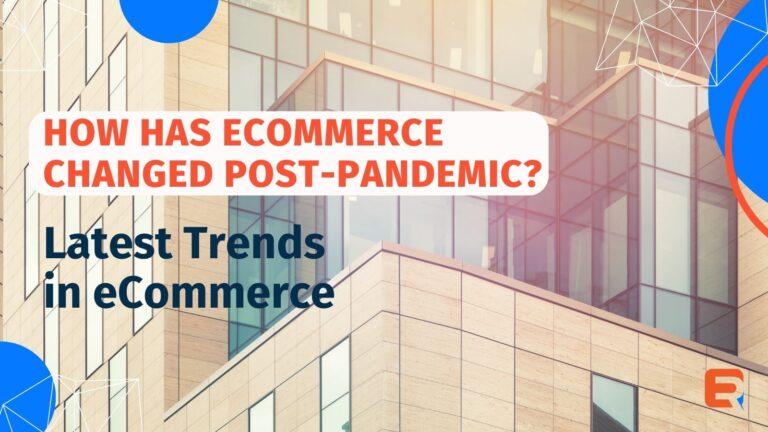At the end of 2020, the world experienced a massive shift toward digitization. Businesses and individuals moved everything online, from selecting and ordering groceries to attending critical business meetings. It was the Covid-19 pandemic that disturbed the personal and professional lifecycles of consumers around the world.
Surprisingly, some of the most well-established brands couldn’t cope with the massive surge of Covid-19 worldwide, resulting in serious revenue falls and even closures. However, the eCommerce industry was quick to respond. Many trends in eCommerce helped brands adopt new approaches ranging from better UI/UX for online stores to “buy now, pay later” features to keep consumers engaged.
Due to the pandemic, markets experienced a change in shopping habits and consumer behavior. An extensive study from IATA states that nearly 2 billion people were shopping online. Further, revenues started skyrocketing, and the eCommerce industry showed more growth potential than before!
The Impact of the Covid-19 Pandemic on the eCommerce Industry

The challenges and growth potential in the eCommerce industry will keep increasing post-pandemic. Covid-19 led to consumer behavioral shifts and buying patterns that helped eCommerce businesses adapt to new market conditions.
At the start of the Covid-19 pandemic, people preferred staying indoors. In fact, many working professionals and executives were operating from home during business hours. This led to a rapid increase in online shopping and, consequently, a boom in consumers’ buying behavior.
eCommerce sales for 2021 surpassed $4.9 trillion worldwide, according to the report on Statista. Moreover, the report shows a 50% growth potential that would increase annual retail eCommerce sales to nearly $7.4 trillion worldwide.
Due to changing times and inexplicable growth potential in the industry, new trends in eCommerce can help you revamp your business/brand. Here’s what you can offer to attract new customers, increase sales, and become a leader in your market!
The Latest Trends in eCommerce Post-Pandemic
People embraced social distancing, online shopping, and contactless deliveries/payments during the Covid-10 pandemic. However, as we enter the post-pandemic world, people remain attached to some of those trends, mainly online shopping. Here are some of the trends in eCommerce that came as a result:
“Buy Now, Pay Later” Payment Methods
Did you know that over 45 million US consumers were already using the buy now, pay later payment feature in 2021? That number is expected to rise; therefore, adopting the feature as a payment method could help you stay competitive in the dynamic eCommerce industry.
It’s a business payment model where customers order and start using products but pay over time in small amounts. You may have heard it as installment payments, deferred billing, or shop now pay later. The payment method is generally interest-free.
Some studies also show that US consumers earning between $50,000 and $99,999 annually prefer the “buy now, pay later” feature over traditional credit card purchases. It allows users to purchase with more freedom and reduced financial strain. It can help resolve cart abandonment issues and boost sales, resulting in higher customer lifetime value as they build better trust with an eCommerce brand.
Mobile-Friendly eCommerce
Mobile-friendly digital stores were among the biggest developments that came to the eCommerce industry during the pandemic. Previously, online shoppers were accustomed to using laptops and desktop computers. When mobile phones started becoming a necessity and smartphone usage made up greater proportions of people’s average screen time, eCommerce businesses were quick to adapt.
The companies streamlined the processes, resulting in a faster shopping experience. Extensive UI/UX research finally paid off when eCommerce brands found ways to make their digital stores mobile-responsive! People preferred using hand-held devices to make instant online purchases and review products/brands. So, it makes complete sense to look into this eCommerce trend.
Drone Delivery
Have you seen some of the short video clips that show brands testing the use of drones as the new delivery guys? The concept of driverless delivery has finally become a reality as eCommerce brands and businesses have adopted drone delivery. Although it’s one of the best trends in eCommerce, it’s still in its initial phase. Companies like Dominos, Amazon, and UPS are in the advanced stages of realizing the “drone delivery” dream that consumers have thought about for so long.
Voice Search-led eCommerce
Google announced that it was developing the voice search feature to understand speech better. This meant the tech giant introduced more textual content to the voice search engine where knowledge graphs, rich snippets, and instant results will match user queries perfectly.
This has helped US consumers tremendously because now, they don’t even have to type in the name of the product or brand in the search engine. With a single tap, they can verbally communicate an entire search query.
Many eCommerce brands, including Amazon and NorthFace, have adopted this trend. These eCommerce leaders are producing voice assistants to ease the online shopping experience for consumers worldwide.
Increased Loyalty Programs and Associated Perks
Do you know that countless adult US consumers prefer loyalty programs over plain payment options? Well, loyalty programs with personalized offers and discounts became one of the most popular post-pandemic trends in the eCommerce industry.
People love buying multiple items from their favorite brands simultaneously because it saves time and money. Therefore, eCommerce brands opted for customized loyalty programs to impress customers and retain their interest in the business.
eCommerce stores can analyze users’ purchase history to create personalized offers and discounts for repeat purchases. The offers include freebies, upcoming purchase coupons, cash-back, discounts, and free delivery or “no-shipping fees” deals.
A Rise in Subscription-Based Models
eCommerce subscription-based payment models refer to recurring billing for ongoing services. A company charges the customer a fee at the end of a specified period for service continuity. Some of the best examples include Amazon Prime, Spotify, and Netflix. These are a few subscription-based business models leading their respective eCommerce markets.
The Bottom Line
There has been a major shift from consumers visiting brands’ brick-and-mortar shops to checking out their online stores with a single tap on their phones! People love the idea of staying at home, browsing thousands of product categories, and having products delivered to their doorstep.
A few trends in eCommerce, such as contactless delivery/payment, rise in B2B sales, and “buy now pay later” schemes, have led to the rapid increase in online shopping. Many eCommerce brands strived hard in the face of the Covid-19 pandemic to retain customers and sales to stay afloat.
References
- https://hbr.org/2021/05/how-e-commerce-fits-into-retails-post-pandemic-future
- https://www.sciencedirect.com/science/article/abs/pii/S0969698921001363
- https://www.iata.org/contentassets/f0e784bf0e024580a8901b9f9e0e5952/e-commerce-monitor.pdf
- https://www.census.gov/library/stories/2022/04/eCommerce-sales-surged-during-pandemic.html
- https://www.sendcloud.com/e-commerce-trends-2020/
- https://www.netsuite.com/portal/resource/articles/eCommerce/eCommerce-trends.shtml
Add great search to your eCommerce site




